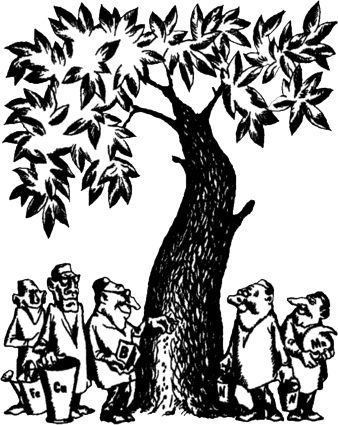107Stories About ChemistryINDEX |
100.
Microelements, the Vitamins of Plants
The word �element� has many meanings. For example, it may mean atoms of one species having the same nuclear charge. But what are �microelements�? That is what we call chemical elements contained in animal and plant organisms in very small quantities. The human organism contains 65% of oxygen, about 18% of carbon, and 10% of hydrogen. These are macroelements, since they are present in large quantities. But titanium and aluminium may be called microelements because their content is only a thousandth of a per cent each.  At the dawn of biochemistry nobody ever paid any attention to such trifles. A mere hundredth of thousandth of a per cent was really nothing to speak of, the more so that at that time such small quantities could not even be determined. As engineering and analysis methods progressed scientists began to find more and more elements in living matter. However, for a long time the role of microelements remained unknown. Even today, though chemical analysis enables determination, of millionths and even hundred-millionths of a per cent of impurities in practically any sample, the importance of many microelements for the vital activities of plants and animals has not yet been established. But there are some things that have been established. For instance, it is known that various organisms contain such elements as cobalt, boron, copper, manganese, vanadium, iodine, fluorine, molybdenum, zinc, and even... radium. Yes, radium, though in trace amounts. Incidentally, about 70 chemical elements have been detected so far in the human organism and there are grounds to believe that the human body contains the whole Periodic System. Moreover, each element plays a certain definite part. There is even an opinion that many disorders are due to a disturbance of the microelemental equilibrium in the organism. Iron and manganese play an important part in plant photosynthesis. If a plant is grown in a soil not containing even traces of iron, its leaves and stem will be white as paper. But if such a plant is sprayed with a solution of iron salts it immediately acquires its natural green colour. Copper is also needed for photosynthesis and affects the assimilability of nitrogen by plant organisms. A deficiency of copper in plants results in poor formation of proteins of which nitrogen is a constituent. Complex organic molybdenum compounds are constituents of various enzymes. They promote nitrogen assimilation. Molybdenum insufficiency may result in leaf blight owing to excessive accumulation of nitrates, which are not assimilated by the plants in the absence of molybdenum. Molybdenum also influences the phosphorus content in plants. In its absence inorganic phosphates do change into organic phosphates. Molybdenum insufficiency also affects the accumulation of pigments (colouring matter) in plants; the leaves become spotted and pale. In the absence of boron plants assimilate phosphorus badly. Boron also promotes better transfer of various sugars through the plant�s system. Microelements play an important part in animal organisms too. It has been found that the complete absence of vanadium in the food of animals causes a loss of appetite and may even prove lethal. On the other hand, increasing the amount of vanadium in pigs� food results in rapid growth and in the formation of a thick layer of fat in them. Zinc plays an important part in metabolism and is a constituent of animal erythrocites. When an animal (or a human being) is in a state of excitement, its liver ejects manganese, silicon, aluminium, titanium and copper into the general blood circulation cycle, but if the central nervous system is inhibited only manganese, copper, titanium are ejected, the evolution of silicon and aluminium being retarded. Besides the liver, the content of microelements in the blood is regulated by the cerebrum, the kidneys, the lungs and the muscles. Elucidation of the role of microelements in the growth and development of plants and animals is an important and very exciting task of chemistry and biology. Solution of this problem will doubtlessly yield substantial results in the near future and will provide science with one more path to the creation of a second nature. |





